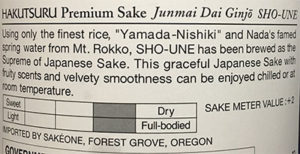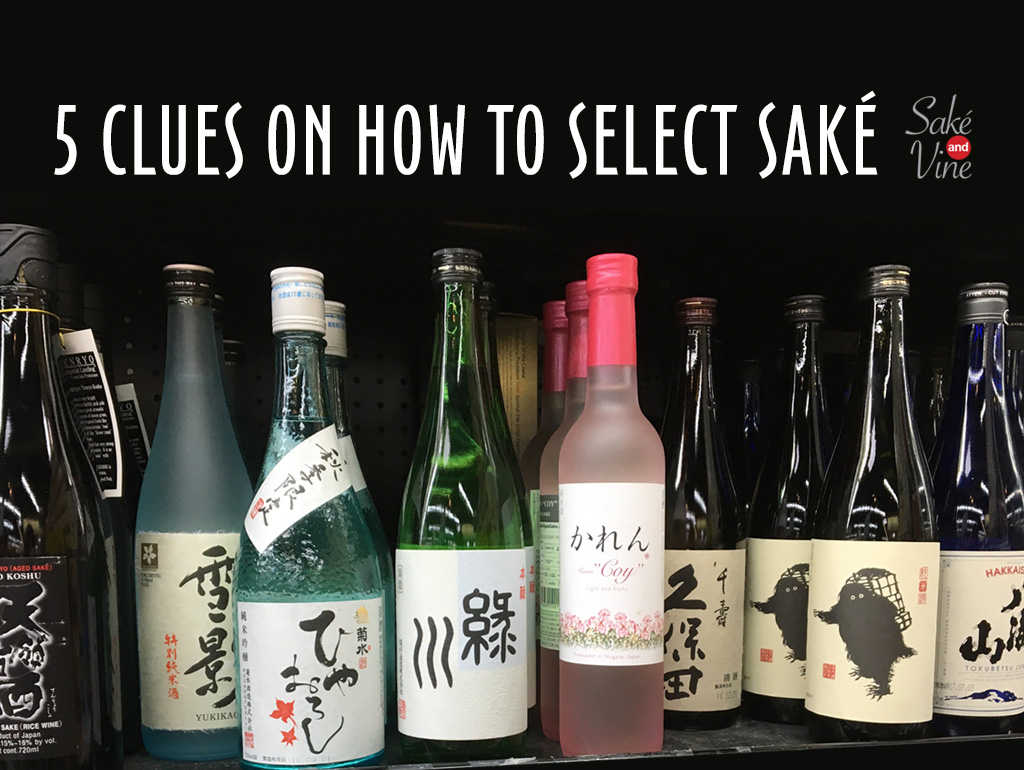5 Clues to Understanding Saké
So you’re curious about the new Sake craze, but you can’t read Japanese and have no idea where to begin? Then let me share 5 helpful hints that can assist you in making a selection with confidence and start enjoying Japanese Sake today!
Don’t get intimidated by the label, go out there and try a bottle!Anyone mentions Sake, and our minds immediately go to a piping hot beverage served at Japanese restaurants that also gave us a heck of a headache the next day. Truth be told, the generic Sake served in a Tokkuri (a small ceramic pitcher) at many of these “Japanese” restaurants are low-grade products that have to be heated up to conceal their bitterness and flawed flavors.
Many are discovering these days the existence of premium sakes crafted by dedicated Sake teams, utilizing centuries-old, tried, and true methodology handed down from one generation to the next, much like how notable wines are created.
With Asian fusion and other comestible expansions in the culinary world, these premium Sakes are joining the ranks of noteworthy wine and craft beers as a desirable beverage option for food pairings and pure libation enjoyment. Also, premium Sakes (designated as Junmai) are made from natural ingredients of rice, yeast, Koji (agent to convert starch to sugar), and water*. That means no more concerns for morning-after headaches.
So, if you’re interested in giving Sake a try, here are 5 clues you can glean from a Sake label to acquire general aroma/flavor profiles. No need to be able to read Japanese! Please note that these clues are meant for general assessment purposes only and are NOT meant as ways to interpret exactness in profiles of Sake. The only way is, of course, to taste it!
Here are 5 clues:
Clue #1: Look for the bottling date
– Sake, unlike wine, is not meant to be aged. So fresher, the tastier. Look for Sake that has been bottled within a year or so (see example). Should you come across Sake with a bottling date that dates back years, I recommend looking for another bottle.
And once opened, the bottle should be kept refrigerated to slow down the oxidation and should be finished within a week of opening.
Clue #2: What type of Sake is it?– Look for “Junmai” (this word can be printed on the front label). This word means it is made only with rice, yeast, Koji, and water*, and no other additives are added. Others are labeled “Daiginjo,” “Ginjo,” “Kimoto,” “Yamahai,” or “Honjozo,” which are also made with rice, yeast, Koji, and water; however, these have a small amount of brewer’s alcohol added to bring out the flavor/aroma profiles.
Just as in wine, it will be impossible to convey exact aroma/flavor profiles for each of the premium Sake grades, as various factors such as types of rice, water, yeast, brewing temps, and methodology can all influence the final Sake profile.
Here are some loose characterizations for each category:
– Junmai Daiginjo –
can be complex, refined, and delicate in aroma/flavor profiles with floral/fruit/herbaceous. Best enjoyed chilled.
– Junmai Ginjo —
can possess pronounced fruity aroma/flavor profiles such as ripe pear, melon, apple, banana, and even tropical fruit. It can also be complex with steamed rice, nougat, or arugula as added flavors.
– Daiginjo/Ginjo, —
can be fruity or floral and complex. These grades are without the word “Junmai” attached, so these Sakes will have an added brewer’s alcohol added to bring out the flavor/aroma profiles.
– Kimoto/Yamahai —
can be earthy, funky, and fun. This type is especially soul-warming when enjoyed heated.
– Honjozo-shu – can be light, fruity, fragrant, or even earthy.
Clue #3: What is the rice milling or Seimaibuai (jp) percentage number mean?
– Even if you cannot read Japanese, you will see a percentage number on the front or back label showing the milling percentage. This number reveals how many outer layers from each grain of rice have been milled down to be used in the brewing process. The lower the percentage number, the more refined the Sake flavor. Higher the milling number, Sake can have an earthier quality to the finish.
Clue #4: What is the SMV (Sake Meter Value) or Nihonshudo (jp) number mean?
– There is a number on the back label next to “SMV” or “Nihonshudo.” This number reflects the sweetness or dryness of Sake. +3 is considered neutral on the sweet/dry scale; therefore, if you are interested in a drier Sake, look for a higher +#. Conversely, if you are interested in a sweeter Sake, you would be looking for -# (such as -10 or more for a cloudy Sake with rice lees called “Nigori-zake”), which tends to be supple and much sweeter.


Clue #5: All premium Sakes are brewed with special Sake rice and not with table rice. – Not all Sake labels may list the name of the Sake rice in English; however, it is worth looking for. There are 60+ types of Sake rice in existence, and a dozen or so rank higher than others for being considered premium Sake rice.
This is one way to determine that the Sake you are about to purchase is a premium Sake if the label shows that the Sake was brewed using “Yamada Nishiki,” for example, as this particular rice type is considered “the king of Sake rice.” Other notable rice names you might see on the label might be Gohyakumangoku, Ōmachi, or Miyama Nishiki.
Bonus Clue: Should all Sakes be drunk hot?– In actuality, premium Sakes should be enjoyed slightly chilled (much like white wine) and served in a wine glass so that you can fully appreciate its aromas as you would drinking wine.
Some brewers may have placed their serving temperature suggestions on the back label, but if you do not see it, try it first slightly chilled. Then try tasting it again when the Sake has come up to room temperature. Some Sake’s aroma/flavor profiles reach their full expressive state at room temperature rather than chilled temperatures. Or, even try it warmed too! (warm Sake by immersing the vessel containing Sake into a pot of warm water, DO NOT heat Sake in a microwave, as this will strip away all the outstanding flavor/aroma profiles).
Finally, no hard rule dictates that you can only drink Sake with sushi or other Asian dishes. Sake is so versatile and food-friendly that they pair well with many dishes such as pizza, burgers, spaghetti, and even BBQ.
Experiment with Sake and have fun with it!
* This article provides general information on how to read Sake labels for purchase, and it is not meant to provide in-depth information regarding the comprehensive Sake brewing process. Simplified references are made here to convey pertinent points without going into specifics.

